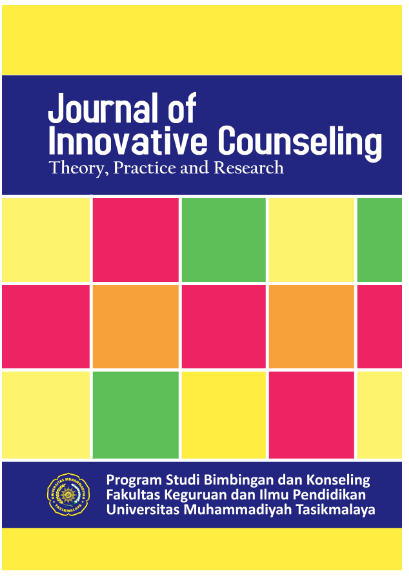Efektivitas Konseling Kognitif Perilaku Untuk Mereduksi Adiksi Cybersex
Keywords:
Behavioral cognitive counseling, cybersex, studentAbstract
The study aimed to examine the effectiveness of cognitive-behavioral counseling to reduce students' cybersex addiction tendencies. This research using a quantitative approach. The research method used is quasi-experiment with SSR (Single Subject Research) research design. The data collection technique was carried out using a cybersex addiction questionnaire. The research sample was XII grade students of SMA N 8 Tasikmalaya in the 2020/2021 school year with a total of 167 students from 2020/2021 school year with a total number of students consisting of 167 MIPA class students and 167 IIS class students who have cybersex addiction. IIS class students who have low cybersex tendencies. using statistical analysis, namely descriptive quantitative by describing results from finding measures of central symptoms including mean, median, mode and standard deviation. standard deviation. The results showed that there were three categories levels of cybersex addiction tendencies, namely: high levels of cybersex addiction, moderate level of cybersex addiction, and low level of cybersex addiction. Treatment treatment on the high category is focused on the reduction towards the low category. The results showed that cognitive behavioral counseling approach counseling approach is effective to reduce cybersex addiction. Counselors are expected to be able to to apply cognitive behavioral counseling to reduce cybersex addiction.
Downloads
References
ABKIN. (2007). Rambu-rambu Penyelenggaraan Bimbingan dan Konseling dalam Jalur Pendidikan Formal. Jakarta. Departemen Pendidikan Nasional.
Beck, A. T., Rush, A. J., Shaw, B. F., & Emery, G. (1979). Cognitive therapy of depression. New York, NY: Guilford Press.
Beck S. Judith. (2011). Cognitive behavior Therapy. New York London. Guildford Press.
Beck, A. T. (2008). The evolution of the cognitive model of depression and its neurobiological correlates. American Journal of Psychiatry, 165, 969– 977.
Byun, S., et al. (2009). Internet addiction: metasynthesis of 1996 – 2006 quantitative research. Cyber Psychology & Behavior. Vol. 12, Number 2, p. 203-207.
Candra, Ifani & Pratiwi S N. (2018). Hubungan Antara Religiusitas dengan Cybersexual Addiction pada Siswa SMP Muhammadiyah 1 Kota Padng. Vol. 11, No. 2, Hal 11-20. ISSN 2502-8766
Caplan, S. (2002). Problematic internet use and psychsocial well being. Development of a theory based cognitive-behavioral measurement instrument. Computer in Human Behavior, 18, 553-557.
Carners, P. J., Delmonico, D. L., & Griffin, E. J. (2001). In the shadows of the net. Center City: Hazelden Foundation.
Chou, Chien., Condron, Linda., & Belland Jhon C. (2005). Review Of the Jurnal Research on Internet Adiction. Educational Psycholog Review, 17, (4).
Cooper, A. dkk. (1998). Sexuality on the Internet: From Sexual Eksploration to pathological Expression (online). Profesional Psychology: Research and Practise, 30(2):154-164.
Cooper, A.,Delmonico, D. L.,&Burg, R. (2000). Cybersex users, abusers, and compulsives:New findings and implications. Sexual Addiction & Compulsivity: The Journal of Treatment and Prevention, 7(1–2), 5–30.
Daneback, Kristian. Cooper. Mansson. (2005). An Internet Study of Cybersex Participants. Vol. 34, No. 3, Hal 321-328
Delmonico L. David & Griffin J . Elizabeth. (2011). Cybersex Addiction and Compulsivity. Internet Addiction. Canada: John Wiley & Sons, Inc.
Edutechnolife. (2011). Pengguna internet di Indonesia mayoritas menggunakan ponsel (internet mobile). Di unduh dari http://edutechnolife.com/pengguna-internet di-indonesia--mayoritas-menggunakan-ponsel-internet-mobile/
Golberg, P. D. (2004). An Exploratory Study About The Impacts That Cybersex (The Use Of The Internet For Sexual Purposes) Is Having On Families And The Practices Of Marriage And Family Therapists. Tesis. Virginia Polytechnic Institute and State University, Falls Church, Virginia, U.S.A.
Greenfield, D.N. (1999). Psychological characteristics of compulsive Internet use: A preliminary analysis. CyberPsychology and Behavior, 2(5), 403 – 412
Griffiths, M. (2005). A ‘‘components’’ model of addiction within a biopsychosocial framework. Journal of Substance Use, 10, 191–197.
Herring, S. C. (1996). Computer-mediated communication: Linguistic, social, and cross-cultural perseptives, 81-106.
Juditha Christiany. (2020). Perilaku cybersex pada generasi milenial. Jurnal Pekommas. Vol.5, Hal 47-58
Kaplan M. David, Tarvydas M. Villa, & Gladding T. Samuel. (2014). Jurnal of Couseling and Development. Volume 92, Hal 366-372
Kwon Hye. Jung. (2011). Toward the Prevention of Adolescent Internet Addiction. Internet Addiction. Canada: John Wiley & Sons, Inc
Kominfo. (2014). Perilaku Anak dan Remaja Dalam Menggunakan Internet. [online] Tersedia di : https://kominfo.go.id/content/detail/3834/siaran-pers-no-17pihkominfo22014-tentang-riset-kominfo-dan-unicef-mengenai-perilaku-anak-dan-remaja-dalam-menggunakan-internet/
S., Mukhopadhyay, T., & Scherlis, W. (1998). Internet Paradox: a social technology that reduces social involvelment and psychological well being. American Pycologist, 53(9), 1017-1031
Maheu. 2001. Etiology and treatment of internet-related problems. Pioneer Depelovement Resource, Inc.
Mark F. Schwartz et al. (2014). Sexual Addiction & Compulsivity : The Journal of Treatment & Prevention. Vol. 7, Hal. 127-144
Ningtyas Yuhana Dewi Sari. (2012). HUBUNGAN ANTARA SELF CONTROL DENGAN INTERNET ADDICTION PADA MAHASISWA. Educational Psychology Journal. No. 1. ISSN 2252-634X
Ropelato, J. (2012). Internet pornography statistics. Retrieved from http://internet-fi lterreview.toptenreviews.com/internet.pornography- statistics.html
Sarwono, Salito W. 2011. Psikologi Remaja. Jakarta: PT Raja Grafindo Persada.
Stevanikova, I., Nie, N. H., & He, X. (2010). Time on the internet at home, loneliness, and life satisfaction: evidence from panel time-diary data. Computer in Human Behvior. 26(3), 329-338.
Van der Aa, Niels., Overbeek, Geertjan., Engles, Rutger C. M. E,. Scholte, Ron H. J., Meerker, Gert- Jan., dan Van dem Eijnden, R. J. J. M. (2008). Daily and Complusive Internet Use and Well-Being in Adolesence: Adiathesis- Strees Model Based on Big Five Personality Traits. J Youth Adolescence, (38), 765-776
Watson C. Joshua. (2015). Internet Addiction. in Treatment Strategies for Substance and Process ADDICTIONS. Amerika Counseling Association.




